

In spite of all the official assertions regarding “red lines,” the Kremlin has proven itself impotent against the infiltration of pro-Ukrainian groups crossing the border in the Belgorod region. This is despite the fact that at least 10 billion rubles ($119,800,000) was dedicated solely to the construction of defensive structures in that area. Various lines, such as the “Wagner Line,” the “Surovikin Line,” and even the “Khrenin Line,” have been established along the border regions of Russia and Belarus. Since last autumn, extensive engineering efforts have been undertaken by the Russian side, yet some of the fortifications seem more like projects intended for absorption of budget funds. However, even disregarding potential theft, historical lessons—ranging from the Great Wall of China and Roman ramparts to the Maginot and McNamara lines—raise doubts about the wisdom behind such constructions.
Content
Russian defense lines
What Russians build and how
The cost
Will defense lines help repulse the AFU's offensive?
A History of Failure: From the Great Wall of China to the McNamara Line
Russian defense lines
One of the extensively debated questions regarding the incursions into the Belgorod region by armed formations aligned with Ukraine, namely the Russian Volunteer Corps (RDK) and the Freedom of Russia Legion (LSR), revolves around how their fighters have managed to breach the defense line known as the “abatis line” previously constructed in the region.
Earlier, subversive groups affiliated with the RDK successfully infiltrated the Bryansk region, where authorities had also established “defense line footholds” and proudly showcased them to Andrei Turchak, the General Secretary of the United Russia party and First Deputy Chairman of the Federation Council, during his inspection visit. Among other things, the politician said at the time:
The advancements made in the Bryansk region can be rightfully characterized as remarkable. The border was reinforced to such an extent that even the tiniest mouse would struggle to get through.
Within a few weeks, however, RDK fighters ventured to the border villages of Sushany and Lubechany, recorded a propaganda video there, and safely returned to Ukrainian territory.
Defensive structures are being constructed along the entire “old” Russian-Ukrainian border and beyond. Recent satellite imagery showcasing the fortifications erected by the Russians in the occupied territories of Ukraine has captivated observers of the conflict. Particularly striking are the uninterrupted trenches spanning 70 kilometers from the outskirts of Melitopol to the village of Marynivka near Prymorsk on the shores of the Sea of Azov. The magnitude of the trenches, located directly on the Black Sea coast in Crimea, and the lines of concrete barriers within the peninsula, is awe-inspiring. For instance, in the village of Vitino, trenches and rows of anti-tank concrete “pyramids” (also known as “dragon's teeth”) can be seen right on the beach. Similar arrangements of “pyramids” have been installed in multiple rows on the Ak-Monay Isthmus, connecting the Kerch Peninsula with the remainder of Crimea.

Satellite image of Russian fortifications in Vitino (Crimea)
The Washington Post
According to British military intelligence, Russia has, since the summer of 2022, constructed one of the most extensive fortification systems observed in recent decades, quite possibly since World War II. These fortifications are not only present on the front lines but also extend to the rear areas and along the “old” Russian-Ukrainian border. The exceptional dedication invested in establishing long-term defensive lines, their strategic placement, and the chosen configurations offer valuable insights into the Russian command's strategy and their prevailing priorities in the ongoing conflict with Ukraine.
Russia has, since the summer of 2022, constructed one of the most extensive fortification systems
Based on available assessments, some of the defense lines, such as those in Bryansk and Belgorod oblasts, appear to be entirely ineffective, possibly representing dodgy endeavors orchestrated by local administrations. The defense structures in Crimea and the Luhansk region may hold some military significance, but primarily in the distant future. It is the strategically organized and well-equipped positions in the Kherson and Zaporizhzhia regions that genuinely present a formidable challenge for the Armed Forces of Ukraine (AFU).
What Russians build and how
Taking a comprehensive view of the Russian side's endeavors, the overall picture appears somewhat contradictory. On one hand, they have undoubtedly executed the most ambitious fortification construction project seen in Europe in the past 70 years. A comprehensive system of engineering structures, comprising multiple lines and tailored to the geographical characteristics of the terrain, has been meticulously established. This extensive network spans nearly 1,000 km, covering an area of approximately 100,000 km².
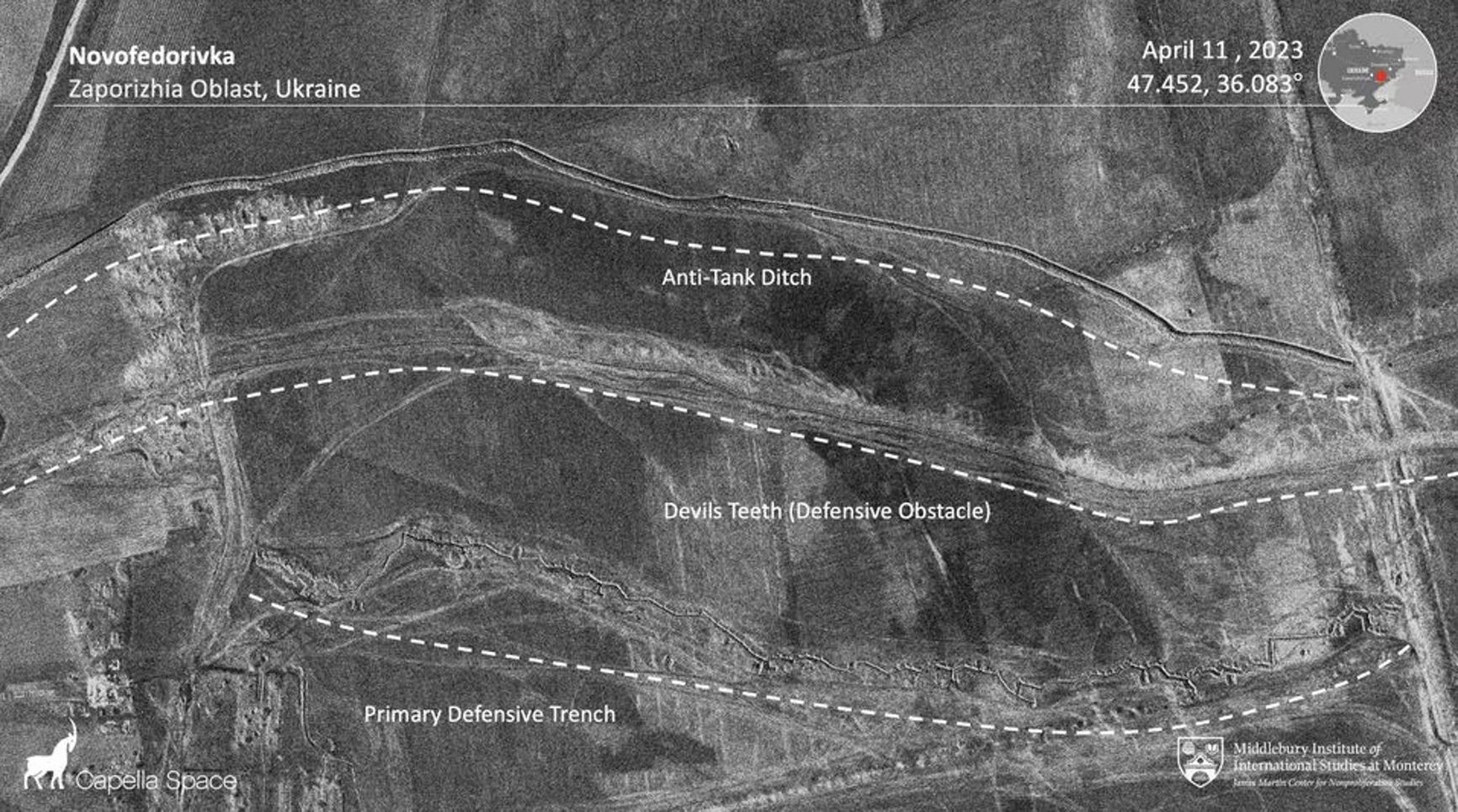
Satellite image of Russian fortifications in Novofedorivka (Zaporizhzhia region)
Capella Space / Reuters
The most extensive network of fortifications has been set up in the south of Zaporizhzhia region and is designed to protect the “land bridge” to the Crimea.
A typical configuration of Russian engineering defenses in the region encompasses the following components:
- Anti-tank trenches;
- Zigzag trenches;
- Concrete bollards (also known as “dragon's teeth”);
- Metal anti-tank hedgehogs;
- Barbed wire fences;
- Minefields.
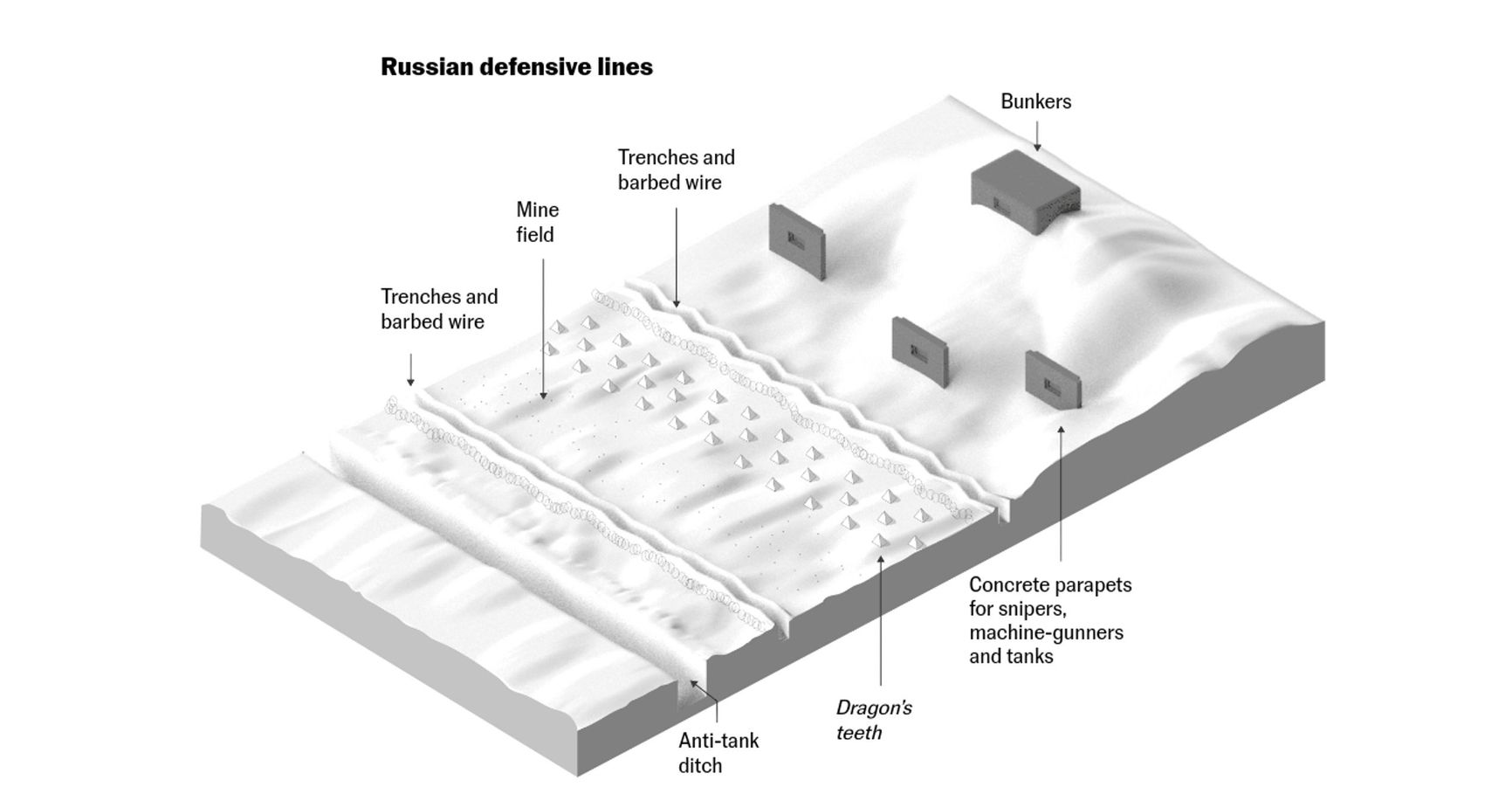
A typical configuration of Russian defense lines in the Zaporizhzhia and Kherson regions
Nacho Catalán / El País
In the Russian-controlled territory of the Zaporizhzhia region, away from the immediate frontline, it appears that defense structures have been built to encircle the largest cities.
OSINT analyst Pasi Paroinen has released a comprehensive analysis of a specific stretch (Kopani - Robotyne - Tokmak) where Ukrainian forces are currently engaged in a counterattack. Through satellite imagery, Paroinen illustrated the organized system of fortifications and fortified zones. The Russian forces have established a layered defense spanning approximately 30 kilometers, reaching almost up to Tokmak, with the city itself being prepared for comprehensive defense. Analyst Rob Lee emphasizes that the objective of such fortifications is not to create an impenetrable defense, but rather to impede Ukrainian forces from converting a tactical breakthrough into a strategic one, thereby granting the Russians the necessary time to deploy reinforcements.
The Kherson region saw the establishment of an equally expansive network of defense lines, which was referred to as the “Surovikin Line” in tribute to Sergey Surovikin, the former commander and current deputy commander of the Russian forces in Ukraine. These defense structures were strategically constructed along natural boundaries and vital routes. Overall, Western analysts acknowledge that the Russian engineering forces are generally fulfilling their responsibilities proficiently.
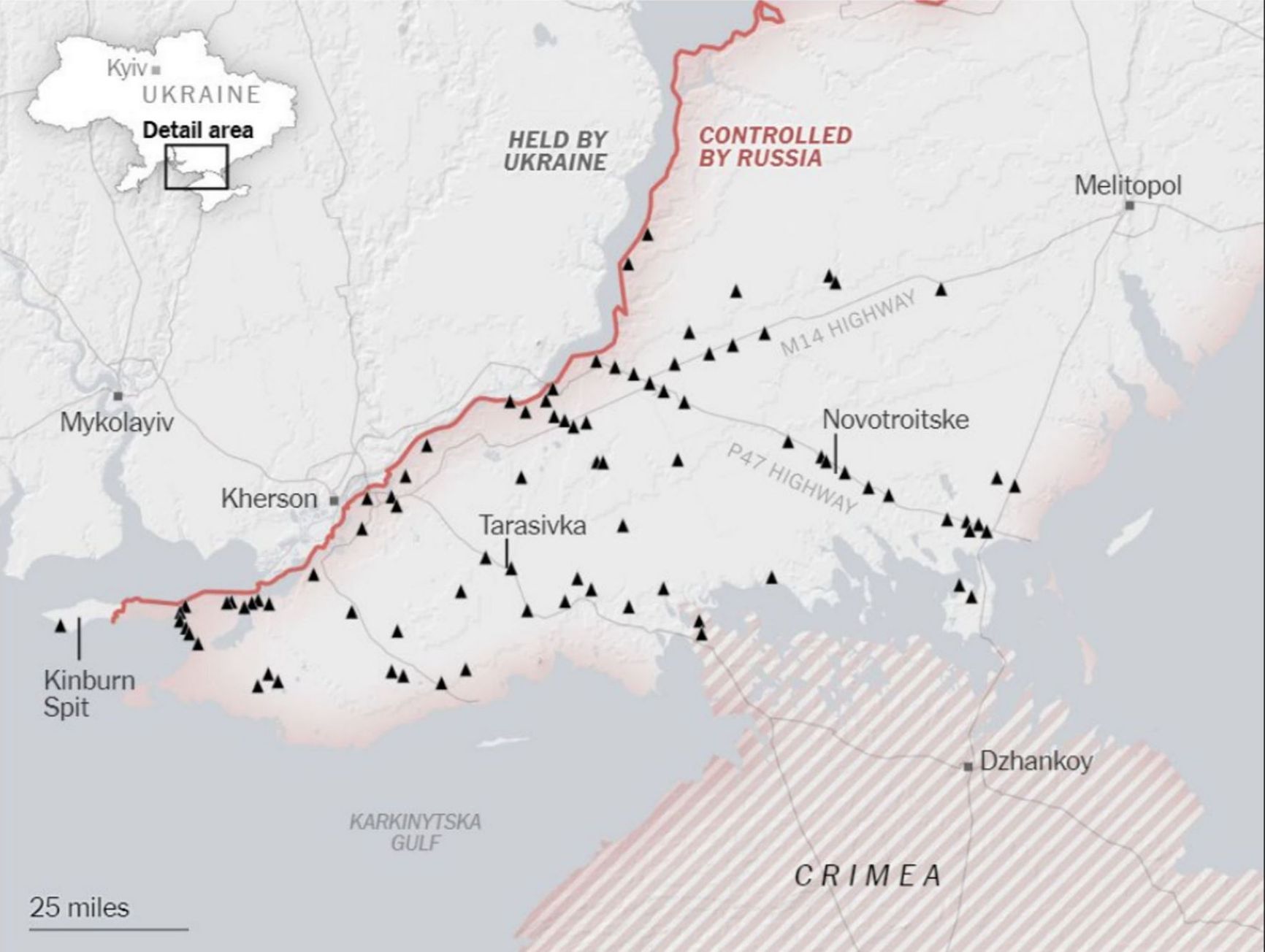
The system of defense fortifications on the territory of the Kherson region occupied by Russian troops
The New York Times
On the contrary, some of the constructed lines are evidently meant for demonstration purposes, if not entirely symbolic. Notably, these include the Wagner Line in the Luhansk Region, the Aksenov Line in Crimea, and the “abatis lines” in the Kursk, Bryansk, and Belgorod Regions. In the rear areas of the Luhansk region, substantial barriers of concrete anti-tank obstacles have been erected near the towns of Popasna, Lysychansk, and Sievierodonetsk. These structures, according to assessments, were likely built by the Wagner PMC rather than the engineering forces, which is why they have been dubbed the Wagner Line by the media. Towards the northern part of the Luhansk region, the defense line extends along the Svatove-Kreminna route, reaching almost to the former Russian-Ukrainian border.
Some of the constructed lines are evidently meant for demonstration purposes
In the north of the Crimean peninsula, less intricate and elaborate lines of trenches and anti-tank trenches have been constructed in its narrowest part. Sergey Aksyonov, the “head” of Crimea, declared in mid-March 2023 that these fortification lines render any “de-occupation” attempts by the Armed Forces of Ukraine (AFU) futile. Just a month prior, Aksyonov had contemplated arranging tours of the defense lines in case they proved to be redundant.
Furthermore, Belarus, which is Russia's de facto ally in the ongoing war with Ukraine, is undertaking certain efforts to strengthen its defenses. Notably, satellite images have surfaced depicting the construction of fortifications in the Gomel region, which have been named the Khrenin Line in honor of Defense Minister Viktor Khrenin.
A noteworthy aspect pertains to the establishment of defensive structures in the Bryansk, Kursk, and Belgorod regions. The most remarkable tale revolves around the Belgorod “fortification line.”
Back in October 2022, the media disseminated the following news:
Vyacheslav Gladkov, the Governor of the Belgorod region, announced that local authorities were implementing protective measures. In an open field, two rows of pyramid-shaped concrete blocks were installed. Such structures are typically utilized as anti-tank barriers.
However, what they were describing with such pathos was the arrangement of rows of concrete pyramids, commonly referred to as “dragon's teeth” or “Wagner's teeth” in the Belgorod region, in an empty field. However, such a defense line would not pose a significant obstacle for tanks, heavy infantry fighting vehicles, or armored personnel carriers. As highlighted by Russian military experts at the time, these “pyramids” could, at best, temporarily impede a pickup truck carrying a sabotage and reconnaissance group.

The “Abatis line” in the Belgorod region
The Real Gladkov / Telergram
Furthermore, it is noteworthy that the “abatis line” was initially constructed not directly on the border with Ukraine but at some distance from it. As a result, the RDK fighters, for instance, were able to enter Novaya Tavolzhanka or the villages in the Graivoron district without much hindrance. Governor Vyacheslav Gladkov openly acknowledged that the primary objective of the protective structures, surprisingly, was not to safeguard the residents but rather to “sober up our enemies.” Consequently, numerous settlements were left in front of the rather symbolic defense line, rather than behind it.
According to Russian authorities, the primary objective of the protective structures was not to safeguard the residents, but rather to “sober up our enemies”
According to regulations, the installation of “dragon's teeth” required them to be arranged in a minimum of six rows, connected by wires or preferably placed on a concrete base. Additionally, anti-tank trenches of two meters in depth and five meters in width were to be dug at an angle that ensured the walls would remain intact. Fields of anti-tank and anti-personnel mines were to be set up, continuous aerial surveillance with drones or the establishment of observation posts was necessary, and sufficient reserve forces needed to be available for immediate deployment in the event of a breakthrough attempt.
Furthermore, road blockades were essential, such as the placement of heavy concrete tetrapods, forcing enemy vehicles to navigate through minefields as they bypassed them. It is worth noting that the proper camouflage of positions, which was not accomplished, was also a requirement. Thanks to satellite imagery, even open data researchers have managed to generate relatively detailed maps of the Russian defense lines (1, 2, 3).
The “abatis line” in the Belgorod region consists of a few lines of concrete pyramids and trenches. However, without the presence of soldiers, artillery, control systems, and surveillance equipment, these structures prove to be ineffective. If there were to be a serious attempt at building a fully operational defense line, complete with manpower and resources, the immediate question arises: where would the necessary personnel and resources come from?

A picture meme from social media: “On the left are Russian anti-tank barriers. On the right are real anti-tank barriers.”
@noclador
However, criticisms have also been raised regarding the Surovikin line. In March 2023, the authors of the controversial DSRG Rusich telegram channel noted the following shortcomings:
- The line is constructed based on outdated maps and fails to consider the terrain in certain areas.
- The soil excavated from the anti-tank trenches is used to create large embankments, obstructing the firing and observation sectors from the positions.
- The dugouts feature weak ceilings consisting of a single layer of boards covered with earth.
- The trenches lack drainage ditches or water pits.
- There is a lack of well-maintained dirt roads along the line to facilitate the movement of vehicles and transportation (or evacuation) of people.
From a broader perspective, investing significant time and resources into constructing a comprehensive system of defense fortifications implies an implicit acceptance of transitioning to strategic defense and adopting traditional positional warfare tactics, with a focus on attrition of the enemy's forces. It is evident that the General Staff of the Russian Armed Forces does not anticipate defending the occupied territories without relying heavily on the extensive fortification lines. It is worth noting that the majority of the construction work, as indicated by satellite imagery, took place after November 2022, when Russian troops withdrew from Kherson.
The cost
In December 2022, during a meeting of the Coordinating Council on the needs of the Russian Armed Forces, Prime Minister Mikhail Mishustin announced that 34 billion rubles ($407,320,000) had been allocated as subsidies to the regions bordering Ukraine. Mishustin stated that these funds were intended for “the development of infrastructure, construction of fortifications, and provision of engineering equipment.”
During a subsequent meeting of the Coordinating Council on March 31, Mishustin said:
“It is also important to continue the construction of fortifications along the troop deployment lines. Most of them have already been fully equipped. Additionally, the construction and re-equipping of new and additional strongholds for the Border Guard Service are underway.”
Precisely in March 2023, the Department of Capital Construction in the Kursk region entered into two state contracts, valued at a combined total of 3.2 billion rubles ($38,336,000), with the Kursk Region Development Corporation for the construction of fortification structures. However, the exact nature and location of these structures were unclear, as the technical specifications were not provided in the bids posted on the government procurement portal. Shortly after journalists discovered the contracts, the information pertaining to them was removed. Based on available photographs, it appears that the fortifications in Kursk are a system of camouflaged firing points.
The situation with the Aksenov line in Crimea is even more complicated. According to Sergei Aksenov, the construction of the defense structures in the northern part of the peninsula was initiated by him personally in the interests of territorial defense. However, it is difficult to see anything beyond the mere absorption of funds behind the trenches that were dug in Yevpatoria and other resort areas along the coast. In the foreseeable future, it is unlikely that the AFU will be able to carry out large-scale operations involving a marine landing. Even if such a scenario were to occur, trenches located directly on the beach would not be effective in preventing a landing.
It is difficult to see anything beyond the mere absorption of funds behind the trenches that were dug in Yevpatoria and other resort areas along the coast
According to political scientist and military expert Pavel Luzin, the construction of defensive lines in the old Russian regions is driven primarily by the interests of local businesses rather than military-strategic considerations:
Local reinforced concrete and cement factories, which are often linked to regional officials, are involved in the construction process. Since these factories may have experienced a decrease in orders during wartime, the construction of the defensive lines could serve as a means of “absorbing budget funds.”
Reinforced concrete “pyramids” have varying costs depending on factors such as concrete grade (this factor is really important), size, and other parameters. They range from 5,000 to 16,000 rubles ($60 to $192) apiece. Plus, there are additional expenses for delivery. For instance, in the Bryansk region, the delivery cost was estimated at 5,000 rubles ($60) per piece, while the “pyramid” itself costs around 7,000 to 8,000 rubles ($84 to $96).
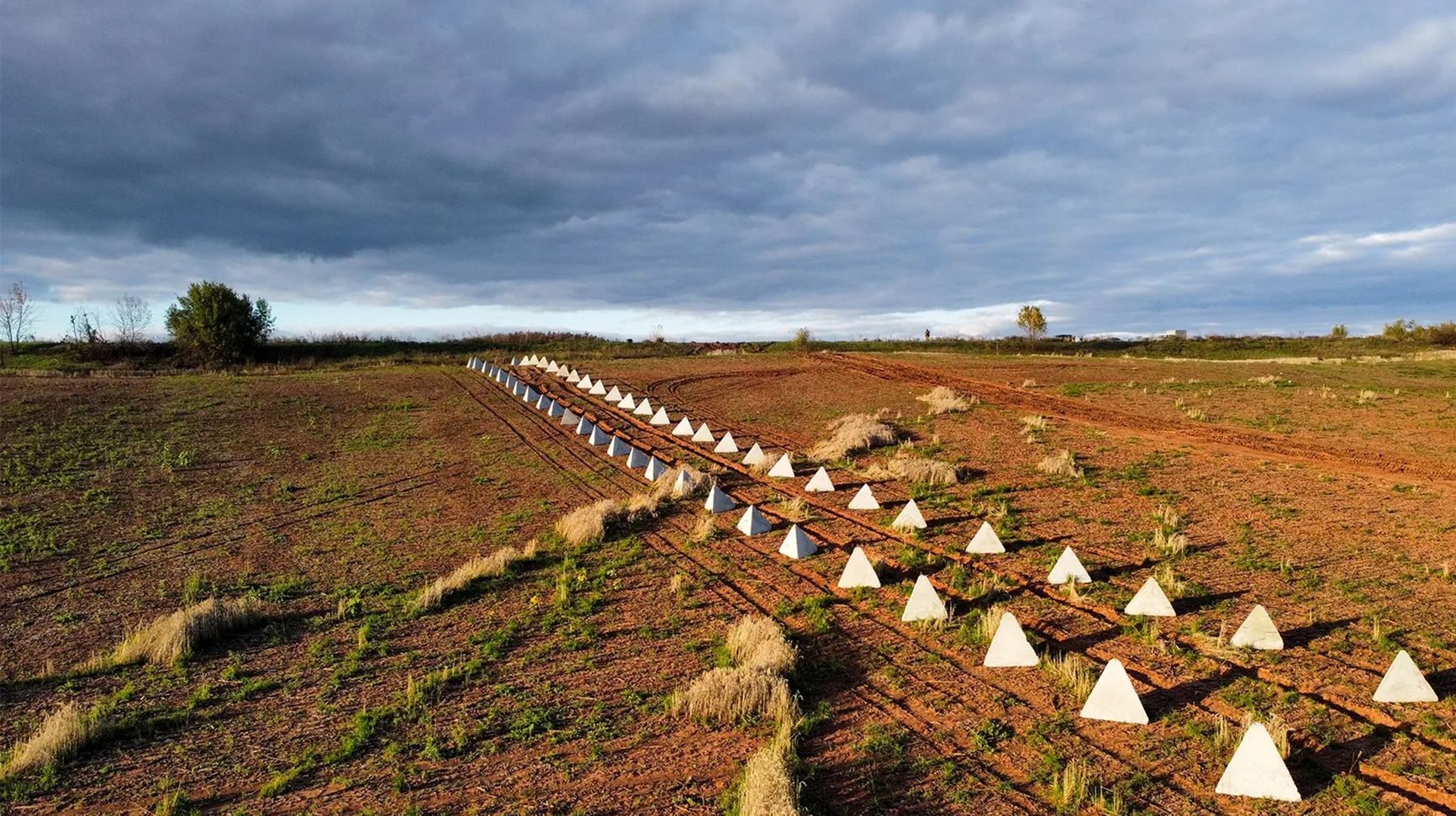
A section of the Wagner Line
RIA FAN
According to calculations by The Moscow Times, equipping one kilometer of anti-tank barriers with a thousand pyramids in four rows requires a significant investment. At a minimum price of 5,000 rubles ($60) per concrete pyramid, the cost for one kilometer would amount to 5 million rubles ($60,000). This estimation does not include expenses for transportation, installation, excavation, and other fortifications and engineering structures.
In the case of the defense line construction in the Bryansk region, an additional 12,000 cubic meters of lumber were required. Local timber companies provided this lumber free of charge.
In the Belgorod region, the construction of the defense line initially began as part of the Wagner Line. However, later on, the local authorities took over the project and renamed it the “abatis line” to avoid sharing funding with Prigozhin's entities. Approximately 10 billion rubles ($120 million) were spent on the project, with reports indicating the involvement of 4,200 people and 680 vehicles at one point during the construction process.
In certain locations, particularly in the rear areas, it appears that some defense lines are being constructed primarily for symbolic purposes. The Russian service of the BBC reported that in the Luhansk region, “pyramids” had been ordered to be made of less durable types of concrete and simply had been dumped in the field. Despite the associated risks, the transportation costs for these pyramids were still considerable, ranging from 15,000 to 20,000 rubles ($180 to $240) per piece. Given the high cost, it is not surprising that even Z-figures like Igor Girkin (also known as Strelkov/Runov) refer to the Surovikin line as the Faberge Line, drawing attention to its exorbitant construction costs.
Will defense lines help repulse the AFU's offensive?
Historical experience has shown that relying solely on lines of defense is not sufficient to ensure reliable defense. However, some experts argue that the extensive fortification efforts by Russian commanders indicate successful adaptation to defensive tasks. It can be agreed that the presence of fortifications and layered obstacle systems reflects a high level of long-term planning.
Nevertheless, maintaining and sustaining such a vast network of trenches, concrete barriers, strongholds, and dugouts would require substantial resources. It is unlikely that all the necessary forces and resources were initially accounted for in the plans.
To effectively control just one kilometer of a fortified defense line, it would require a minimum of 100-120 personnel, excluding drone operators, artillery personnel, support units, and others. Therefore, to adequately cover the border between the Kursk and Belgorod regions with Ukraine, an estimated 80-95,000 personnel would be needed.
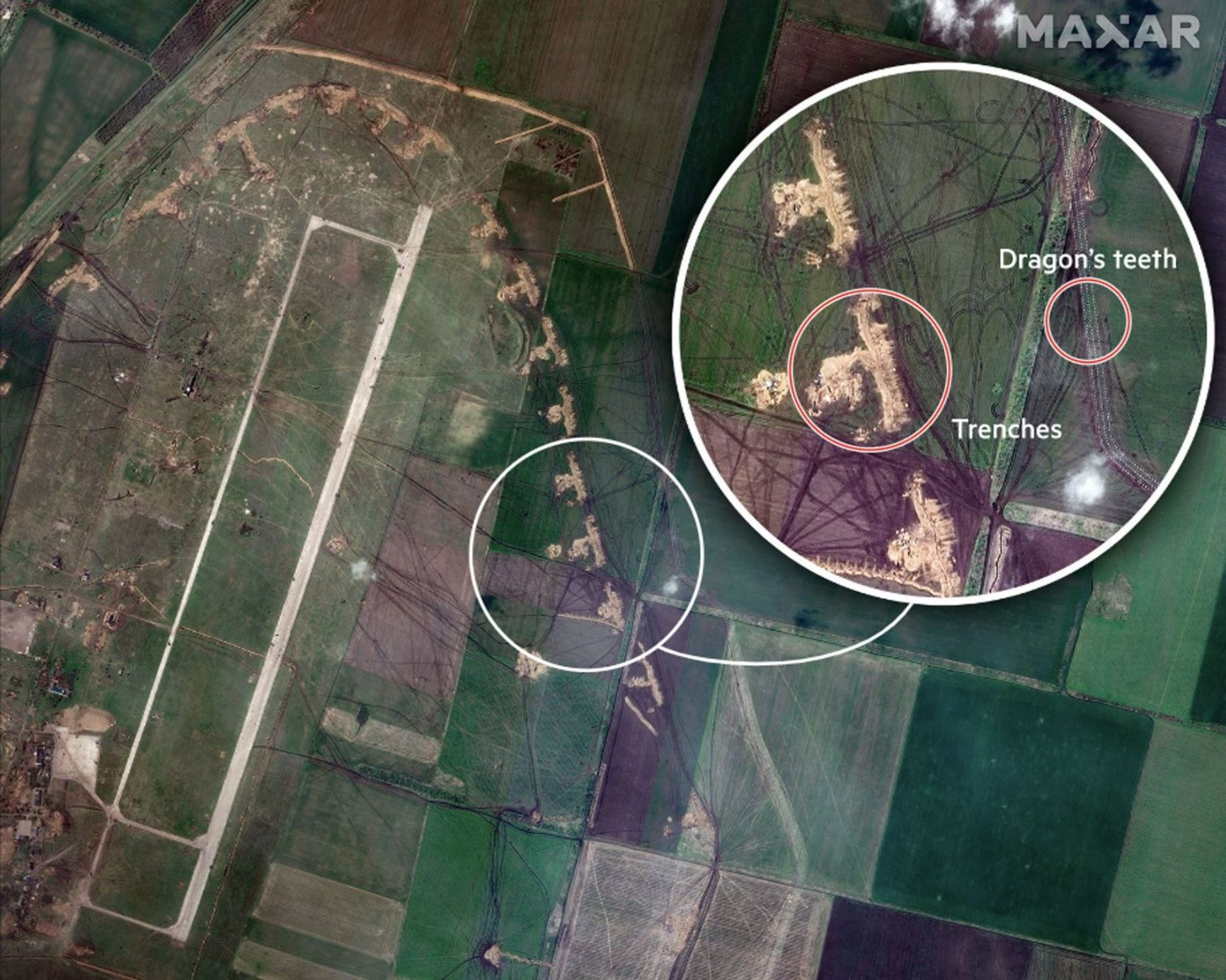
A system of Russian defenses near the Berdyansk airport (Zaporizhzhia region)
Maxar / Financial Times
It is possible that the initial purpose behind the extensive construction of defense lines was to send a clear political message to Ukraine, as well as to interested parties in Russia and the West, demonstrating the determination to defend the currently occupied territories at any cost.
The well-constructed defense lines in the Zaporizhzhia and Kherson regions are likely to significantly impede the advancement of the AFU and provide time to mobilize reserves and organize a counteroffensive. However, without proper logistical support, personnel, equipment, and training to repel enemy offensives, these defense lines may not fulfill their intended function.
Regarding the border regions of Bryansk, Belgorod, and Kursk, the funds invested there appear to have been wasted. The “abatis line” in these areas lacks a cohesive defense structure, and the fortifications are currently occupied by regular conscripts rather than border guards. Supplies are provided by volunteers. It would be more effective to relocate inhabitants from areas within the range of Ukrainian artillery and deploy highly mobile rapid reaction forces equipped with advanced border control technology.
A History of Failure: From the Great Wall of China to the McNamara Line
Throughout military history, there have been numerous examples of large-scale defense structures. One of the most renowned examples is the Great Wall of China, which spanned thousands of kilometers and was constructed over a period of nearly 2,500 years. However, despite its grandeur, the massive defensive wall did not prove highly effective in its primary objective of repelling invasions from nomadic tribes to the north, as China was periodically conquered by them.
A similar pattern can be observed with the Roman barrier ramparts. Notably, Hadrian's Wall and Antonine's Wall in Britain (which inspired George Martin's depiction of the Wall in the epic series “A Song of Ice and Fire,” on which the Game of Thrones series was based) successfully deterred major incursions by northern “barbarian” forces but were not impervious to breaches. Nevertheless, the incorporation of earth mounds, walls, and fortified structures became a widely recognized “gold standard” for border fortifications.
Although earth mounds and walls were not impervious to breaches, they became a widely recognized “gold standard” for border fortifications
In the early 20th century, formidable lines of concrete fortifications incorporating various defensive elements emerged. These included machine gun nests, underground tunnels, artillery positions, extensive barbed wire entanglements, mines, and intricate trench networks. During World War I, the Germans built the impressive Hindenburg Line named after Field Marshal Paul von Hindenburg. They used a lot of resources, including 500,000 tons of rock and rubble, 100,000 tons of cement, and 12,500 tons of barbed wire. In September 1918, following intensive artillery preparation and aided by the emergence of tanks in significant numbers on the front, the Allied forces were able to break through the Hindenburg Line within a few days.

Poster with a French soldier in front of the Hindenburg Line shown on a map (highlighted in red)
Library of Congress, Washington, D.C. (cph 3f03935)
During the period between the two World Wars, most European countries embarked on the construction of their own defense lines, leading some researchers to refer to this era as a “fortification fever.” However, for the most part, these defense lines did not play a significant role during actual combat operations.
One notable exception is the Soviet-Finnish War, where the Mannerheim Line, named after Field Marshal Karl Gustav Mannerheim, is often mentioned. Soviet propaganda linked the unsuccessful winter offensive of 1939-1940 to the fortification system on the Finnish portion of the Karelian Isthmus. However, it is now known that there was no continuous chain of long-term fortifications in the form of a line, and the existing fortifications had notable shortcomings in their technical execution. The main difficulties faced by the Red Army were attributed to more practical factors.
Within the USSR itself, the construction of the Stalin Line had been underway since the late 1920s. In 1940-1941, the Molotov Line was added to it. These lines consisted of fortified structures, concrete bunkers, and equipped artillery positions. The Molotov Line was situated along the new border between the USSR and Germany following the partition of Poland in 1939, while the Stalin Line ran along the old border. It is believed that the German attack in 1941 left the Molotov Line unfinished and led to the partial abandonment of the Stalin Line. At best, these defense lines managed to delay the German advance towards Moscow for a few months.
Similar to other defense lines of its time, the Maginot Line in France, named after Minister of War André Maginot, followed a similar pattern. The construction project spanned 10 years and involved immense efforts, including the excavation of 12 million cubic meters of earth, the pouring of 1.5 million cubic meters of cement, and the supply of 150,000 tons of steel, amounting to a cost of nearly $4 billion in today's currency. However, when the German army launched its offensive in 1940, it took only six weeks for them to defeat and occupy France. Despite being hailed as a “military engineering miracle,” the Maginot Line ultimately failed to halt the German advance, although it did force the German command to undertake daring and risky maneuvers.

Artistic depiction of the inner workings of the Maginot Line
ADAGP / Paris - Musée de l'Armée
Yet, the Germans themselves made the same mistake. They invested significant resources and manpower in constructing various defense lines, such as the Atlantic Rampart along the European coast, the Siegfried Line in western Germany, and the Gustav Line in southern Italy. However, despite these formidable fortifications, the Allies successfully executed landing operations and achieved victory.
In some cases, defense lines were rendered useless without even requiring a direct assault. An example of this is Mussolini's Alpine Wall, a massive system of mountain strongholds constructed over nearly 20 years along the northern borders of Italy in the Alps region, spanning approximately 2,000 kilometers. However, the Alpine Wall proved ineffective.
As a countermeasure to Italy's Alpine Wall, the Rupnik Line was built in Yugoslavia during the late 1930s, named after General Leon Rupnik. However, the line was scheduled to be completed by 1947, so when the German invasion began, any defense proved impossible. Subsequently, the fortifications were demolished to salvage valuable metals. Although the nature of warfare after World War II changed, defense lines continued to demonstrate their futility.
Although the nature of warfare after World War II changed, defense lines continued to demonstrate their futility
During the peak of the Vietnam War, the Americans had a plan to shut down the Ho Chi Minh Trail to insurgent forces using an advanced defense system known as the McNamara Barrier Line, named after Secretary of Defense Robert McNamara. This initiative was developed in 1966 and relied on extensive utilization of electronic sensors, aerial surveillance, aerial mines, precision strikes with smart munitions, and was projected to require an annual budget of $1 billion. However, due to its exorbitant expense, among other reasons, the McNamara line was never implemented as originally intended. By 1969, it was deemed unsuccessful, and in 1973, the United States withdrew its troops from Vietnam.
The Bar-Lev Line, constructed by the Israelis between 1968 and 1969, was a series of fortifications erected along the eastern bank of the Suez Canal. It extended for 160 kilometers and was named after IDF Chief of Staff Chaim Bar-Lev. The total cost of building the line amounted to $300 million. Israel's intention was to create a defense system that would require the Egyptian army several days to breach. However, during the 1973 war, the Egyptians managed to destroy the sand barriers using water flows from pumps in just a few hours.
These cases illustrate a broader point that static lines of defense, regardless of the financial resources, time, and effort invested in them, can be overcome through a sufficiently powerful strike or through the enemy's ingenuity.